Someone once said that if you don’t exist on country radio, you don’t exist at all. While independent artists and even mainstream acts like Eric Church and Miranda Lambert have proven this is false, the fact remains that radio is still the most efficient way to grow musical careers in country music. Even though radio is losing popularity as a digital medium in the era of streaming, it remains the bedrock of the genre. Arguably more than any other genre, country fans turn to traditional radio stations to discover new music, listen to their favorite artists and entertain themselves. While I firmly believe in the long run consumers will shift to newer methods such as streaming, in today’s age country radio still asserts a large influence over which artists are selling and touring well. This equates to revenue and the bottom line for what many artists and their labels are chasing.
Therefore, with July 1 marking the halfway point of 2020, I set out to examine trends, winners and losers of country radio’s last 42 months. To do this, I compiled a dataset of all Mediabase weekly country charts dating back to 2017. This included 177 weekly charts detailing the top 50 songs at the time, with a total of 393 unique songs throughout this time frame. While the performed analysis indicated much of what I expected, there were also some surprises in the data which I will outline in the following sections: good, bad and ugly (with an addendum).
Before I detail these sections, I found it necessary to emphasize two distinct characteristics of country radio’s last few years: consistent and logarithmic. For those unfamiliar with logarithmic functions, just know that their values grow at an increasing rate (examples will be shown). The first example of this validates my main frustration with the radio, in that the same songs are repeated too frequently. Of course, this is how radio works where there is a set playlist that occupy the core hours of airtime, however the extent at which this occurs is even greater than I expected.
Below is a chart which details the total number of spins based on a single’s chart position for the week, as well as the percentage of total spins overall. Naturally, this only includes spins for the top fifty performing songs each week, but these songs generally make up a very large portion of total weekly airtime.
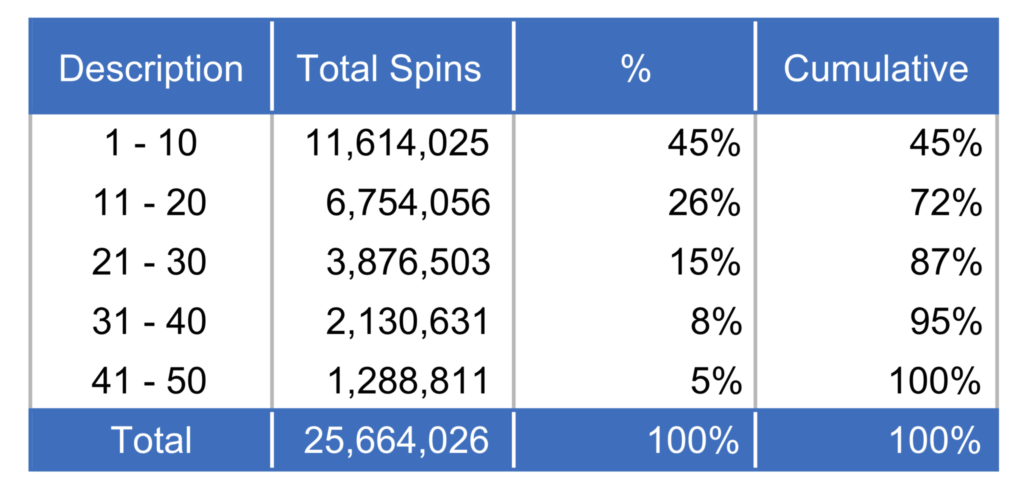
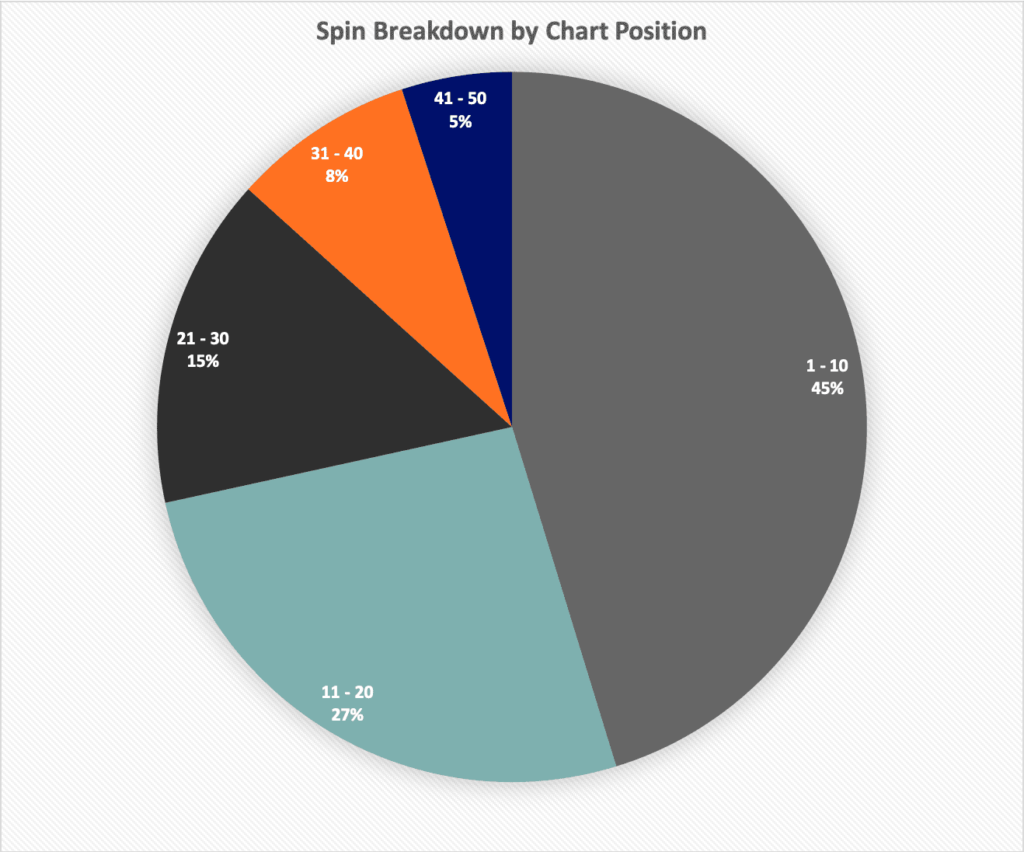
As you can see, the top ten songs each week accounted for almost half of the total spins present in the dataset. This equates to every other song played being one of these ten songs, so it’s no wonder it feels like you always hear the same songs on the radio. Additionally, these numbers drop off quite dramatically as a single’s chart position falls. This is an example of the logarithmic and almost exponential growth seen on the charts where for each tier of chart position, the amount of spins is larger by an increasing amount. This is further illustrated by the pie chart on the right with the top twenty songs consuming nearly 75% of all spins.
These numbers represent all the data since 2017 and are certainly drastic, however what is even more remarkable is the consistency of these percentages. The below figure illustrates the same breakdown of spin percentage by chart position, however mapped over each week in the data.

This figure showcases the incredible lack of variance in this measure week over week. The lines separating the colored slices are remarkably close to being straight lines on the macro scale indicating this ratio of spins (i.e. 45% for the top ten songs) occurred every week with only slight deviations. This is a product of highly regimented playlists and lack of flexibility for hosts (if any at all).
The next chart represents a different but similar view of consistency.
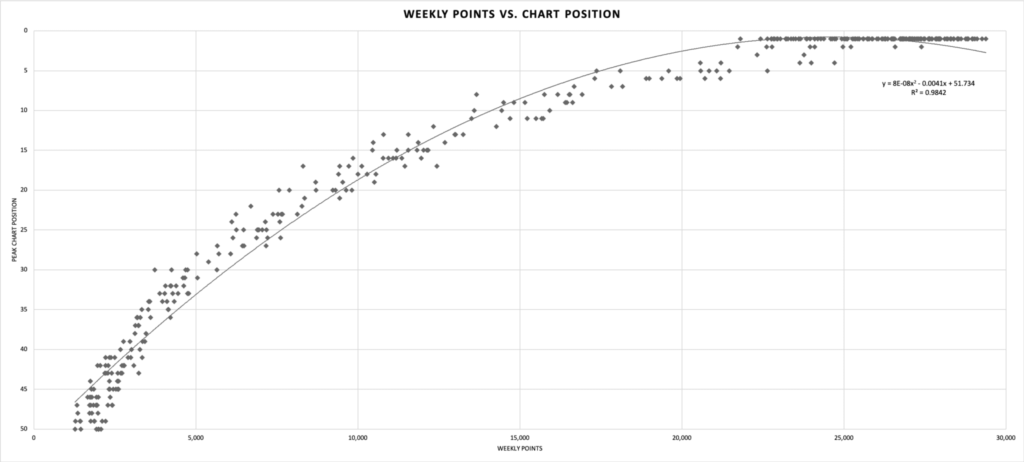
The figure shows the weekly points for each single on the horizontal axis and its subsequent chart position for the week. Mediabase points are calculated based on number of spins for a song and the subsequent audience, therefore weighting spins in markets with larger populations heavier. These points are how the rankings are determined each week, therefore it’s no surprise these points match the regression line with 98% accuracy. In essence, each week the top songs are played way more than the lower charting songs and at the same ratios. Of course, this is how radio stations operate, but the extent of this inequality is extremely significant.
This theme of consistent and logarithmic functions is widely apparent throughout the analysis and explains much of the following key takeaways.
The Good
Anyone who is remotely familiar with the genre of late is aware that Luke Combs is an absolute juggernaut. Since the release of his first single “Hurricane” back in 2017, the everyman of country music has blended contemporary production with great lyricism delivered by a soulful, rich voice. And while there has historically (and currently) been a disconnect between consumer preferences and what gets played on the radio, Combs’ meteoric rise to the top could not be ignored by radio programmers.
While his success was certainly bolstered by the FM dial, he developed a grass-roots fanbase earlier in his career through social media. The flames of momentum from his early following soon began to be fanned by country airwaves across the nation and what has since ensued is nothing short of historic. For as many times as country radio has failed to recognize their consumers’ demand for an artist, Luke Combs is certainly one thing they have got right as his numbers since emerging on the scene are absolutely prolific. Of course, you would expect him to be one of the top performers of the last few years, but as you will see, the advanced breakdown of his run on the charts is nothing short of astounding.
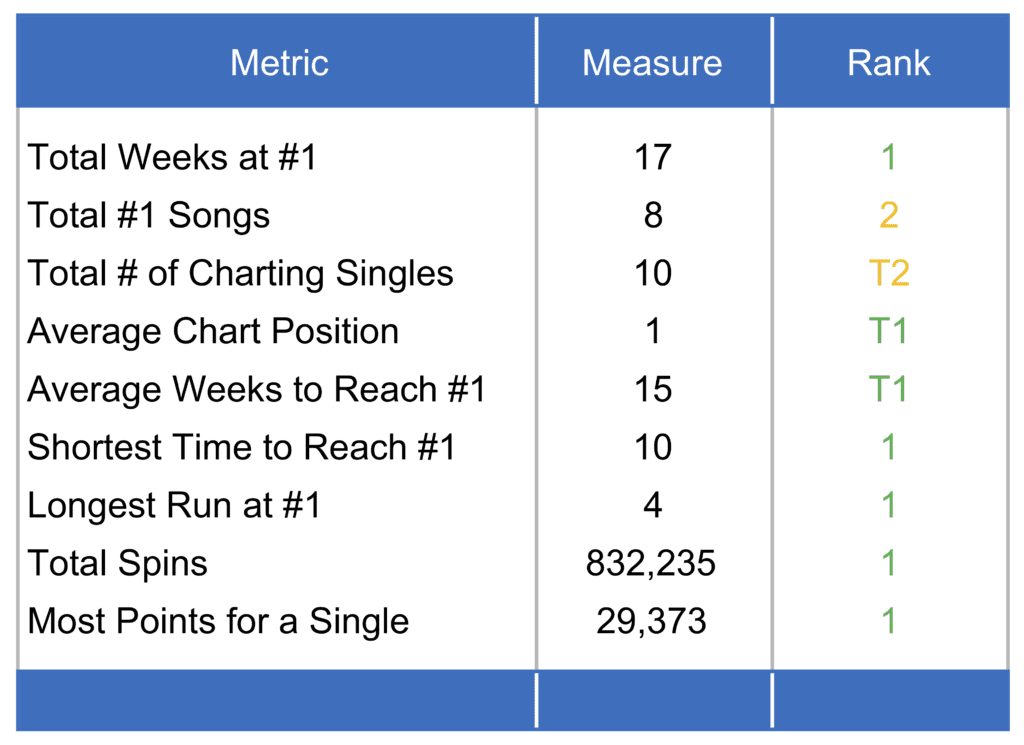
To begin, the above table provides a snapshot of a how Combs has ranked among his contemporaries for country radio statistics.
To put it simply, he dominated. The first measure being total weeks with a song at number one is likely the most impressive. With 17 weeks combined between his eight number ones, he topped the charts for by far the most amount of time with second place going to Luke Bryan at only eleven weeks. Moving down the list, his only “blemish” is having the second most number one songs and second most total charting songs, however he was only one short in both categories. His eight number ones in this time frame is amazing, especially considering they were his first eight songs sent to radio of his career. He’s currently batting .1000 with his average chart position being #1, as all of his official singles have peaked at the top. His quarantine song “Six Feet Apart” was not an official single so does not count for this category, however that song charting as an unofficial single is remarkable in itself.
The final few statistics are equally incredible. On average, his eight number ones have only taken 15 weeks to reach the top, which is tied for the shortest of all artists. Furthermore, his single “Even Though I’m Leaving” peaked at number one in just ten weeks, the shortest of any song in this time period. On top of that, “Beautiful Crazy” spent four weeks at number one which was the longest run of any since 2017. Finally, of course he had the most spins for his combined singles and most points for an individual single (“She Got The Best Of Me”) because bar none he was the most heard voice on country radio in the last few years.
To fully demonstrate how far apart Combs set himself from his contemporaries, I looked at two measures which judged each charting single by its peak position and how many weeks it took to get there. The basic idea is that the quicker a song climbs the charts, the more momentum there is behind it due to genuine passion for the song. Let’s be honest, a song taking 58 weeks to reach number one is not due to sweltering fan support, it’s because of the power of that artist’s label to generate spins. I won’t name names, but a song taking over a year to peak is simply ridiculous.
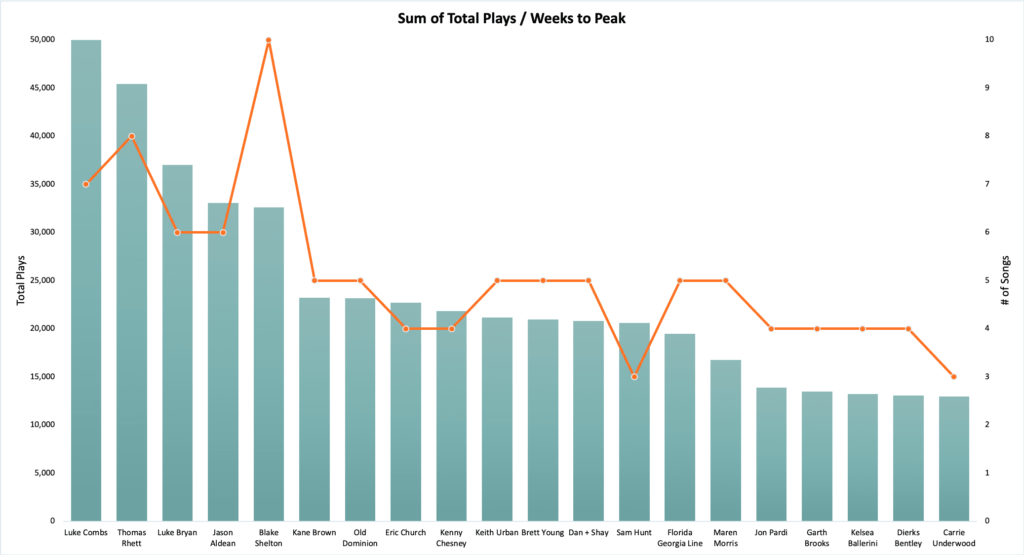
In stark comparison to 58-week chart runs, Luke Combs pumped out number ones quickly and efficiently. The figure above shows artists and the sum of each of their singles’ total plays divided by weeks to peak. As mentioned, this is to measure how quickly songs peak and roughly shows the average spins per week for each song. When summed, it gives a view of the artists’ ability to consistently deliver successful songs and naturally Combs leads by close to 5,000. Additionally, the orange line shows how many songs makes up that sum. In Combs’ case, he leads the pack with one less song than the second ranked Thomas Rhett because his average plays per time to peak was much higher than the competition (~7,200).
To further exhibit his display of greatness, I created a custom metric to evaluate charting singles called PT Points (standing for peak vs. time). This was done using a simple formula:
(Peak Position Points x Number of Weeks at Peak Position) – (Weeks to Peak x 10)
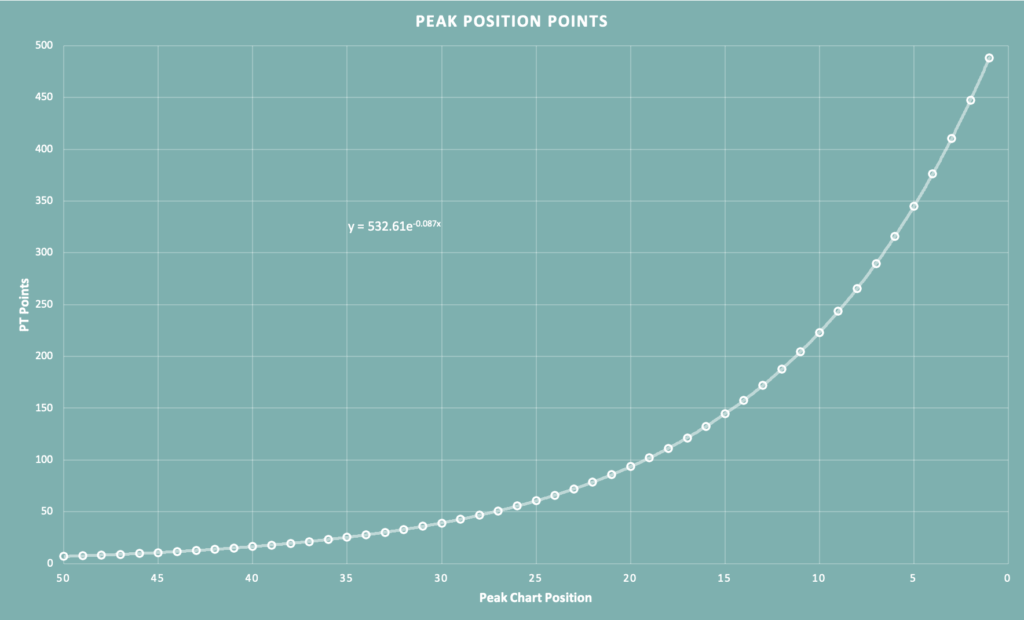
Peak position points are calculated based on a logarithmic function that allocates points at an increasing amount as the single’s peak position increases. For example, a #40 song receives ~16 points versus a #10 song which receives ~223 points. This was done to place an emphasis on top performing songs. A full view of this point allocation can be seen in the figure above.
The results of this analysis can be seen below.

When using this methodology, Combs completely laps the field. Luke Bryan and Jason Aldean are some of the biggest acts of the last two decades, but their charting singles combined barely produced more PT points than Combs alone. This is a testament to how many number ones Combs has had and how quickly they charted. His music is clearly resonating with fans in a vastly superior way to anyone else and he shows no sign of stopping anytime soon.
For one final view of greatness, I used PT points to identify the top ten best performing singles since 2017. Seen below highlighted in red, it’s no surprise that Combs holds the top two spots and three of the top ten. Jason Aldean is the only other artists with multiple songs on this list, but he only had two at #3 and #9 (“We Back” and “You Make It Easy”).
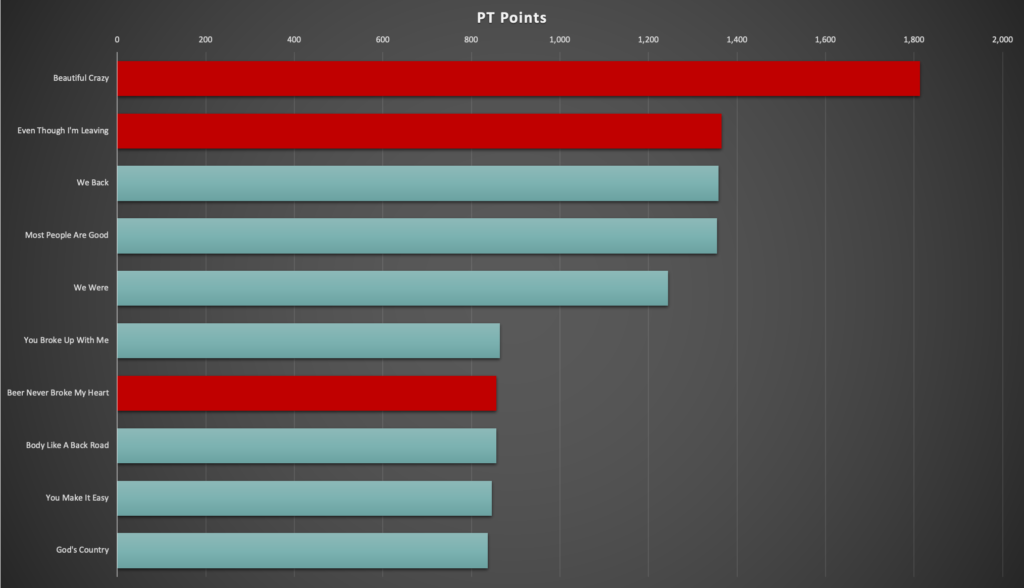
If it’s not clear by now, no one has had a better run on in the last few years than Luke Combs. His pure chart domination to launch his career is unprecedented and is no doubt great for the genre. His sound is a refreshing blend of classic and contemporary, and his respect for country music makes him the perfect artist to be the new face of the genre. I, among many, are certainly thankful that country music has got this one right.
The Bad
When it comes to country radio, there appears to be an extremely large barrier to entry in the form of an artist’s management. While this is not surprising, the continued consolidation of labels on Music Row have made it nearly impossible for an artist to chart a song with an independent record label. This is largely due to the fact that radio stations have limited playlists, and powerful labels leverage their scale and influence to ensure their artists’ music is being prioritized.
Below is a table and graphical representation of the number of charting singles each parent label has had.
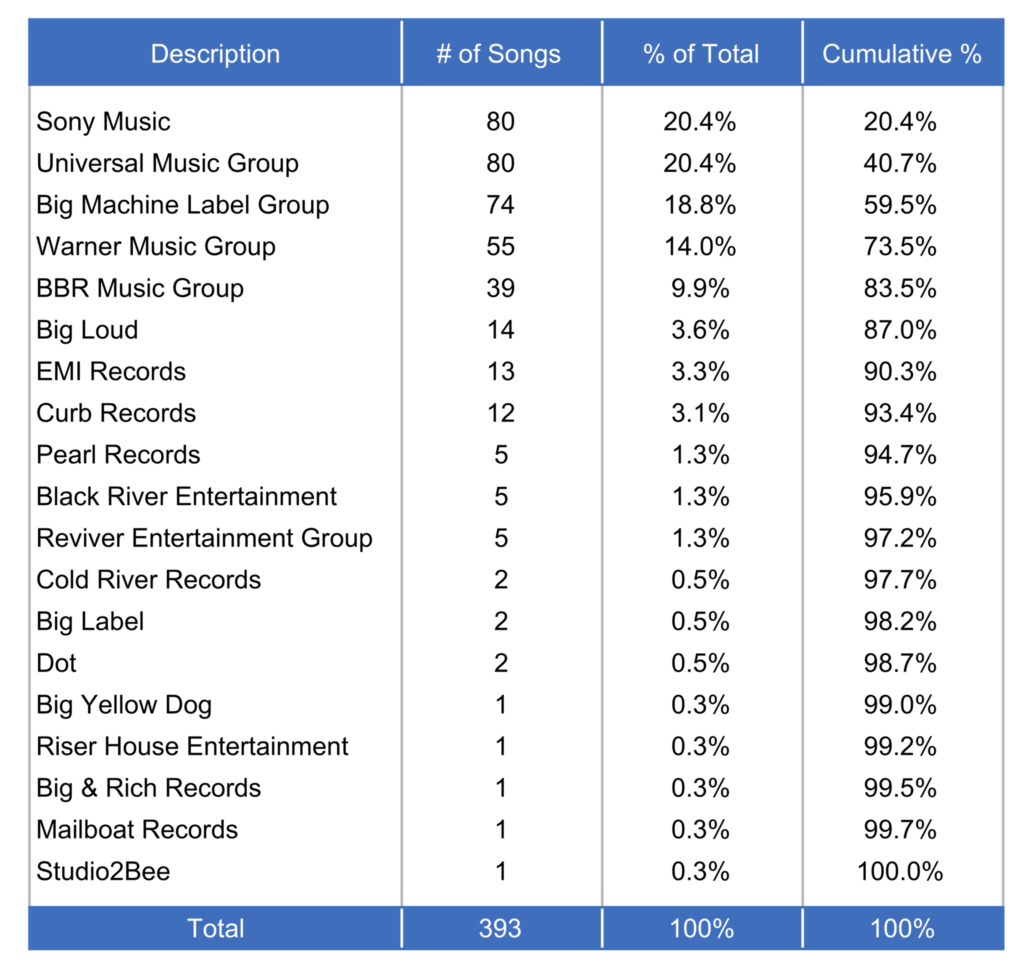
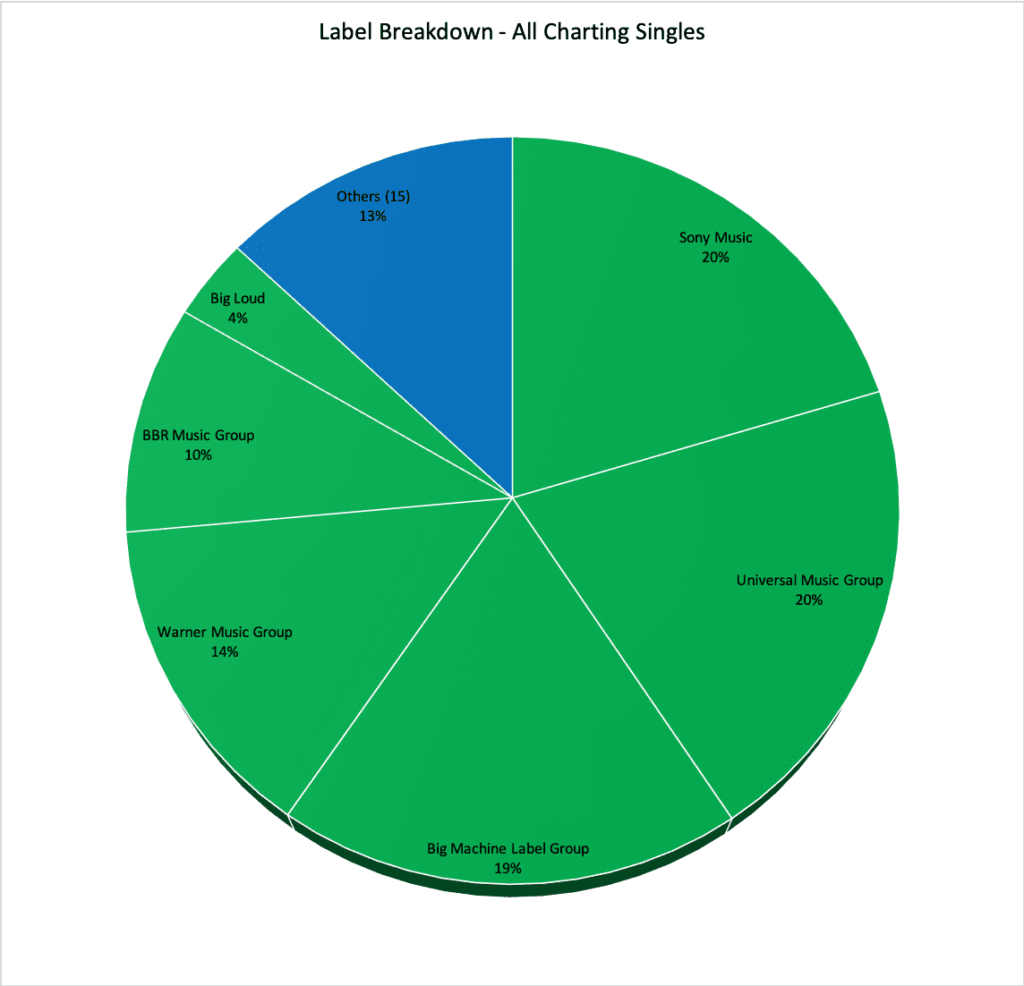
While there appears to be at least a semblance of label diversity, in reality this list is extremely top heavy. The big four labels (Sony, Universal, Big Machine and Warner) make up ~74% of the charts alone, while expanding that down to the top six accounts for 87% of the total 393 songs. This is best represented by the pie chart on the right, where the top six labels are in green and the remaining independent labels are bundled in blue only making up 13% of the pie.
The disparity between the big four and independent labels grows even further when you narrow the dataset to only include top ten charting singles. Upon doing so, the big four account for 153 out of the 194 total (~79%), and the top six 179 (~92%).
Naturally, this trend continues when looking at just number one singles, illustrated by the below figures in the same format.
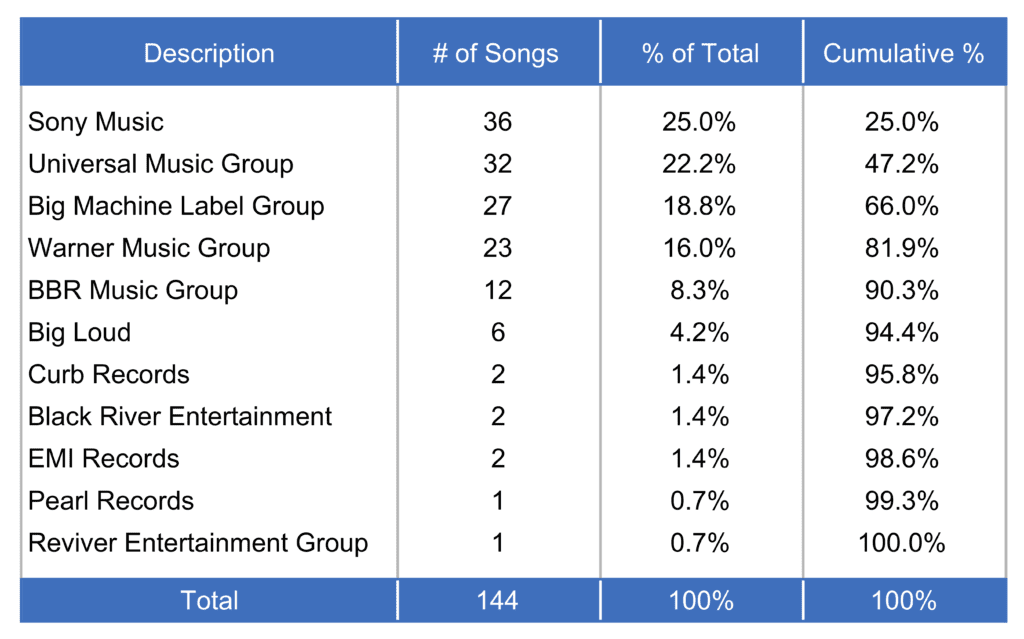

Since 2017, only 11 labels have sent a song to the top of the charts. Of course, there are subsidiaries within the larger labels that are responsible for a varying amount of these singles, but they all roll up into the four conglomerates that essentially control country radio. These four were responsible for the artists that had ~82% of the top charting songs in this period, leaving little room for the smaller labels to gain momentum, much less independent artists without any label representation.
Not surprisingly, the figures for the breakdown of total spins by label are extremely similar and top heavy in nature (see below).
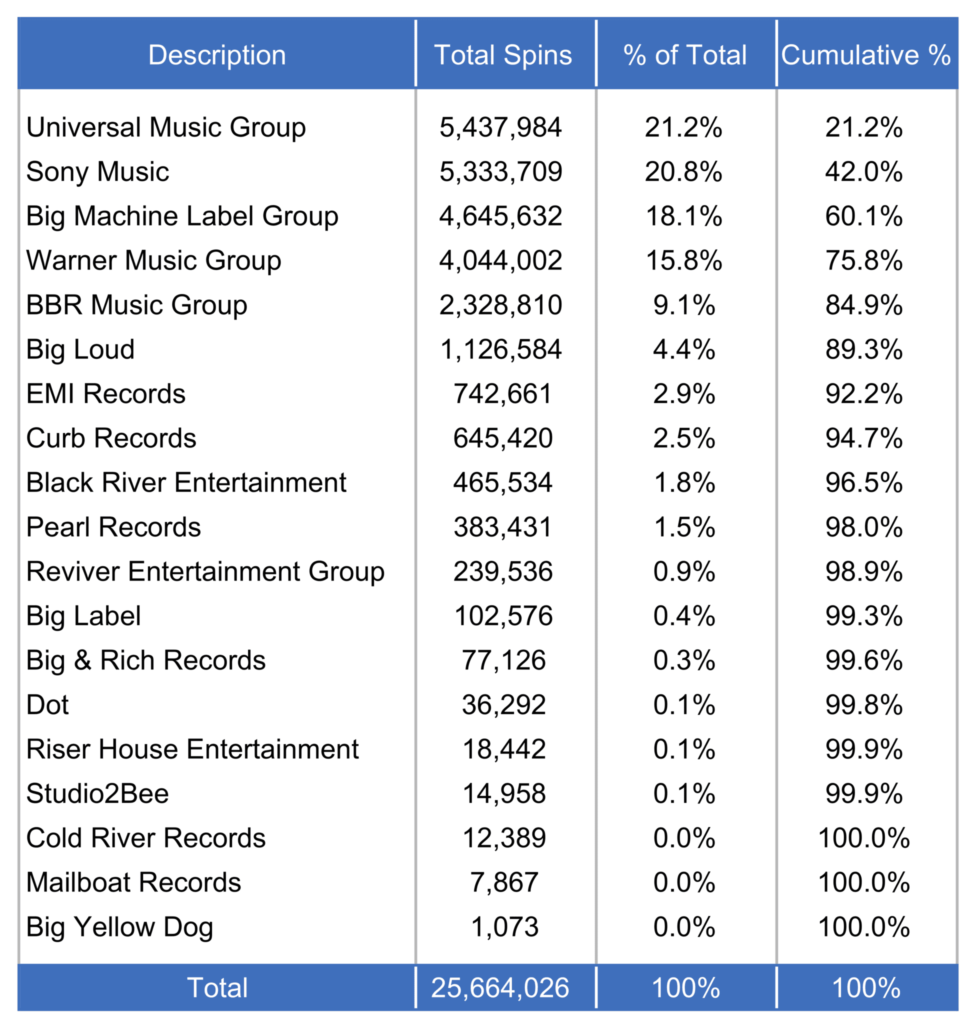
The reality is that besides very few exceptions, artists need to be signed to a major label with major resources to see significant time on the airwaves. This is due to the entanglement between Nashville, Music Row and the major country radio stations. They all work together with symbiotic relationships that churn out smash hit records and superstars year after year.
While this is naturally the evolution of mutually beneficial business relationships, this is so problematic because it has created a homogenous pool of broadcasted country music. The reason why it seems like you hear the same songs repeatedly on the radio is not only because you actually do, but because there are so few labels supplying these songs that their sound profiles all start to become the same. This has become so exaggerated, that recently the writers of Kane Brown’s song “Short Skirt Weather” had to be added to the credits for Florida Georgia Line’s “I Love My Country” as the two songs were melodically so similar.
This is inherently bad for country music because too much of anything can be a bad thing. This is emphatically the case with country radio, where the lack of musical diversity has left a bad taste in the mouths of many fans. For better or for worse, the genre has been pushed to its musical limits in the last decade to the point where there is now a sound on the country spectrum that can appeal to the majority of music consumers. The problem is that country radio does not reflect this and until this changes, the medium will continue to die a slow death at the hands of streaming services which provide this diversity.
Addendum: Country Music Moneyball
While the label consolidation in Nashville has negatively impacted the range of sounds you hear on country radio, there is a ray of hope that has emerged in the last few years. Personally, I’ve always wondered if songs are played on the radio because people like them, or if people like them because they’re played on the radio. While the answer to this question is likely both, the data suggests it is much more the latter. The large, powerful labels in Nashville have the ability and relationships to be able to push their artists’ music through the airwaves and gain popularity for those tracks through pure repetition. However, one label has found success taking the alternative approach and has provided a very interesting case for the future of radio.
A few months before the global COVID-19 pandemic brought the world (and specifically the live music industry) to a standstill, I attended a show at one of my favorite small venues. In between sets, I had the opportunity to converse with the opening act who is an up and coming artist with Big Loud’s label. I proceeded to ask the usual questions I find yield the most fruitful answers in driving honest conversation. Among them, and often most effective, is how they choose their singles sent to country radio, and how much control they retain in making that final decision. The answer I received that night caught me completely off guard. I was informed that said artist had essentially zero say in the single selection, and that the process was done through detailed analysis of fan reaction to each individual song on the artists’ album.
While I wasn’t entirely surprised a young artist didn’t have final say in their single selection, this approach is unique and is not taken to such an extreme by any other Nashville labels. However, I predict that this will not be the case for long as Big Loud has found tremendous chart success of late using this method.
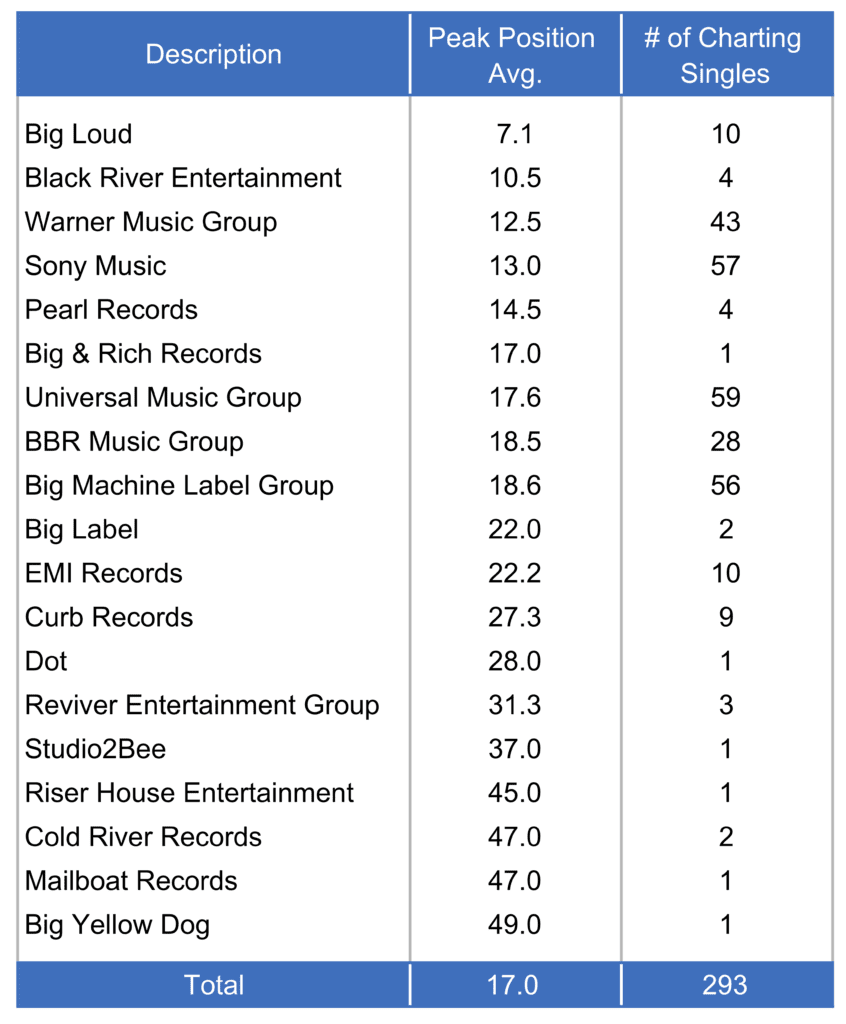
Above is a list of all the labels that have charted a song since 2017, sorted by the average chart position of all their songs combined. Interestingly enough, Big Loud has the best average at 7.1 by over 3 whole positions. Yes, this is a very skewed perspective given Big Loud only had 10 charting singles as opposed to ~60 for each of the big four labels. Those labels had way more number one singles and overall more chart success, however it’s not a fair fight. It’s similar to the case of the New York Yankees versus the Oakland Athletics. In fact, one could say that Big Loud is playing Moneyball in the game of country music, and using it to beat out their competition.
While Big Loud was responsible for launching the careers of the ever-polarizing but undoubtedly commercially success Florida Georgia Line, it is still a very small label. Founded in 2011 with an expansion to create Big Loud Records in 2015, they are a young and small team led by Seth England. Given their youth, they are currently the baseball equivalent of a smaller market team like the Oakland Athletics, who traditionally struggle to compete with the large payroll teams like the Yankees. Yet, just like how Billy Beane used Bill James Sabermetrics to find value in players other teams overlooked, Big Loud has found a method to find value in songs that would be overlooked by others, leading to enhanced single selection and improved chart performance for their artists.
In order to illustrate this, I created a custom metric to compare the performance of charting singles to expectations for that artist. This was done by setting an expected peak chart position for each single, based on a basic Spotify metric, Spotify Artist Popularity. This number ranges from 0 to 100 (100 being the highest popularity) and is calculated by Spotify daily based on number of listeners, streams and other performance indicators. To create the expectations, I graphed every single in my dataset’s peak chart position with that artist’s Spotify Popularity at the day of chart entry for that song.
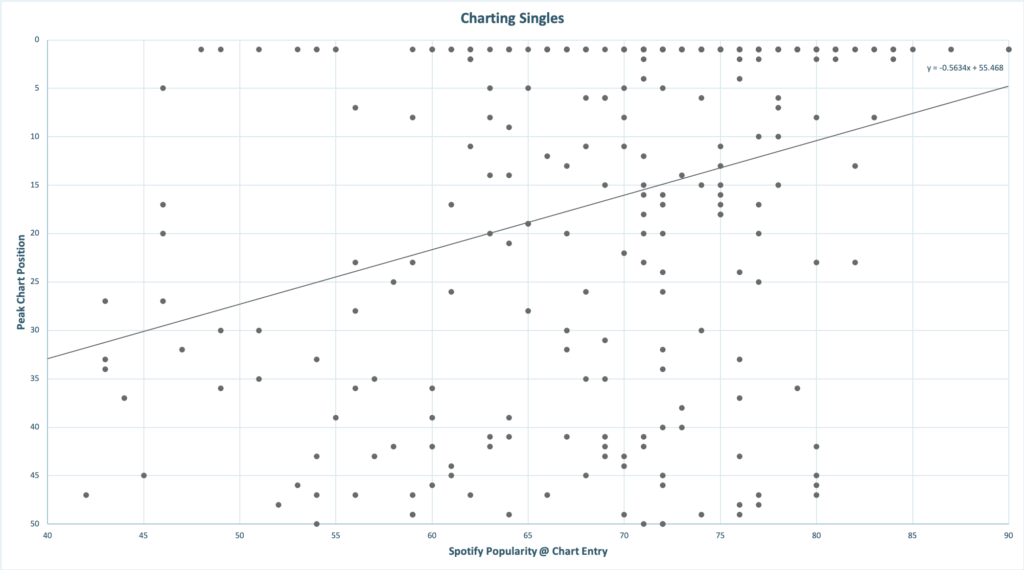
As you can tell, there is not a definitive popularity requirement for an artist’s song to either perform well or poorly on the charts, as there is an infinite amount of reasons for a song to spin well. However, there was a clear trend in that the higher the artist’s popularity was, the higher the song charter on average – as shown by the solid black trendline. This makes sense as an artist with popularity over 80 (i.e. Luke Bryan) is more likely to have a hit song than an up and coming artist with popularity around 50, solely based on his reputation and the support Luke Bryan has from his promotional team. Therefore, I used a linear equation to developed expected peak positions for every Spotify popularity value 0-100 based on the above trend. By doing so, it becomes possible to measure a song and subsequently an artist’s chart performance compared to their expectations, similar to a handicap in golf. The song’s peak position is simply subtracted from their expected position.
The average results at the label level are shown below.
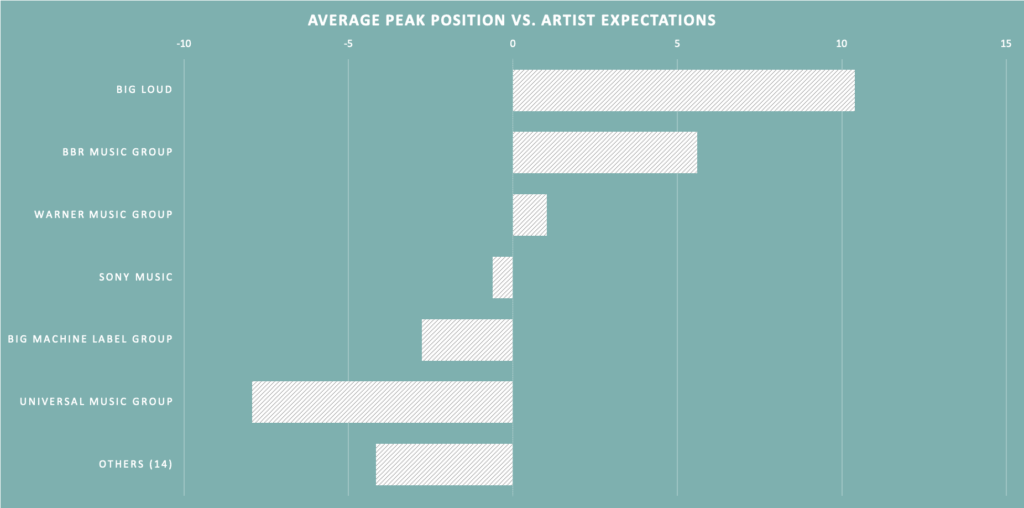
This view validates the Big Loud Moneyball theory as artists signed to that label are charting singles that average a peak over ten slots higher than artists at the same stage of their careers (measured by popularity). This is the difference between a top 20 song and a top 10 song, which is absolutely massive on the scale of country radio charts. Furthermore, it is the highest average for any label by far, with 85% of labels actually averaging a negative chart performance compared to expectations. This makes Big Loud’s run on the charts even more impressive and cements the fact that they are playing a completely different game than their competition.
One could argue that these numbers are again skewed as Big Loud has charted way less songs than the larger labels so it’s not fair to compare them. However, these are based on expectations as opposed to pure performance, making it the only reasonable method for comparisons.
Additionally, one could propose that Big Loud has exceeded expectations more than other labels because their artists are younger on the aggregate, therefore likely having lower Spotify popularities and easier expectations to surpass. It is certainly possible this is the case for their younger artists like Morgan Wallen and HARDY, who just began charting singles in the last few years. But this is negated by Big Loud’s resident veteran artist, Jake Owen.
Owen broke onto the scene in 2005 and has remained a staple in the genre with his beach-infused, feel good country music. The bulk of his career thus far was spent with Sony Music’s RCA Nashville where he enjoyed hugely successful singles like “Barefoot Blue Jean Night”, “The One That Got Away” and “Anywhere With You”. Yet this success started to fade at the end of his American Love era in 2016, especially on radio. So, Owen Left RCA Nashville in November of 2017 to sign with Big Loud where his singles have subsequently performed far better.
Since 2017, Jake Owen has charted five songs. The first two were when he was still with RCA Nashville and peaked at 37 (the lowest charting single of his career) and 32. They fell short of peak position expectations by 16 and 20 positions respectively. In comparison, the next three singles have been through Big Loud and produced two number one singles (“I Was Jack (You Were Diane)” and “Homemade”), and “Down to the Honkytonk” which peaked at number 6. These singles all outperformed expectations and have completely revamped his career. Yes, these songs were off a new album with a different producer, however the fact remains that Big Loud is changing the way singles are picked and creating superior chart performance for their artists, both upcoming and established.
The final and perhaps best example of this comes from one of the most interesting new artists in the genre, HARDY. While he has already established himself as one of the best song writers in Nashville with cuts on an astonishing list of projects, he recently launched a solo career and released a full-length album titled HIXTAPE: Vol. 1. The ten-song album features a record 17 collaborations ranging from legends like Trace Adkins, current superstars like Thomas Rhett and Keith Urban, to relatively newer artists like Lauren Alaina and Devin Dawson.
Of the ten songs on the record, there is one that stands out as the obvious radio smash given its upbeat tempo, and radio-friendly lyrics and big-time collaboration: “Nothin’ Out Here” featuring Thomas Rhett. If he were with any other label, it’s almost guaranteed this would have been the lead single pushed to country radio, and likely performed pretty well. But that’s not the direction Big Loud went.
Instead, they pushed “One Beer” featuring the much lesser known Lauren Alaina and Devin Dawson. Furthermore, while one might think it’s just another drinking song, it’s actually a much more thoughtful reflection on the impact a single beer had on the narrator, involving the life altering consequences of a teenage pregnancy. While I don’t know specific details behind the criteria used in their single selection process, I have a strong feeling that this song was the most well received on streaming platforms when the album was released. This is the data-driven approach Big Loud is taking and thus far it is really working – “One Beer” is top 25 on the charts at the time of this publication and still climbing. Regardless of if “One Beer” tops the charts or not, just as the Oakland Athletics haven’t won a World Series employing Moneyball tactics, this song is a big win for the label and a step in the right direction for country radio.
This number-centric approach to single selection is still in its early stages, but Big Loud is onto something huge that has the potential to completely alter the landscape of not just country music, but the music industry as a whole.
The Ugly
While performing a thorough analysis of the country radio charts, it would be egregious to overlook the massive discrepancies in numbers between male and female performers. This is a well-documented issue and has been raised countless times over the last decade, but the numbers are still disturbingly polarized.
To illustrate this, I charted the percentage of both chart positions and total spins by the gender of each artist (outer ring is based on chart positions, inner ring on number of spins). The results for those two categories are very similar and admittedly very ugly.
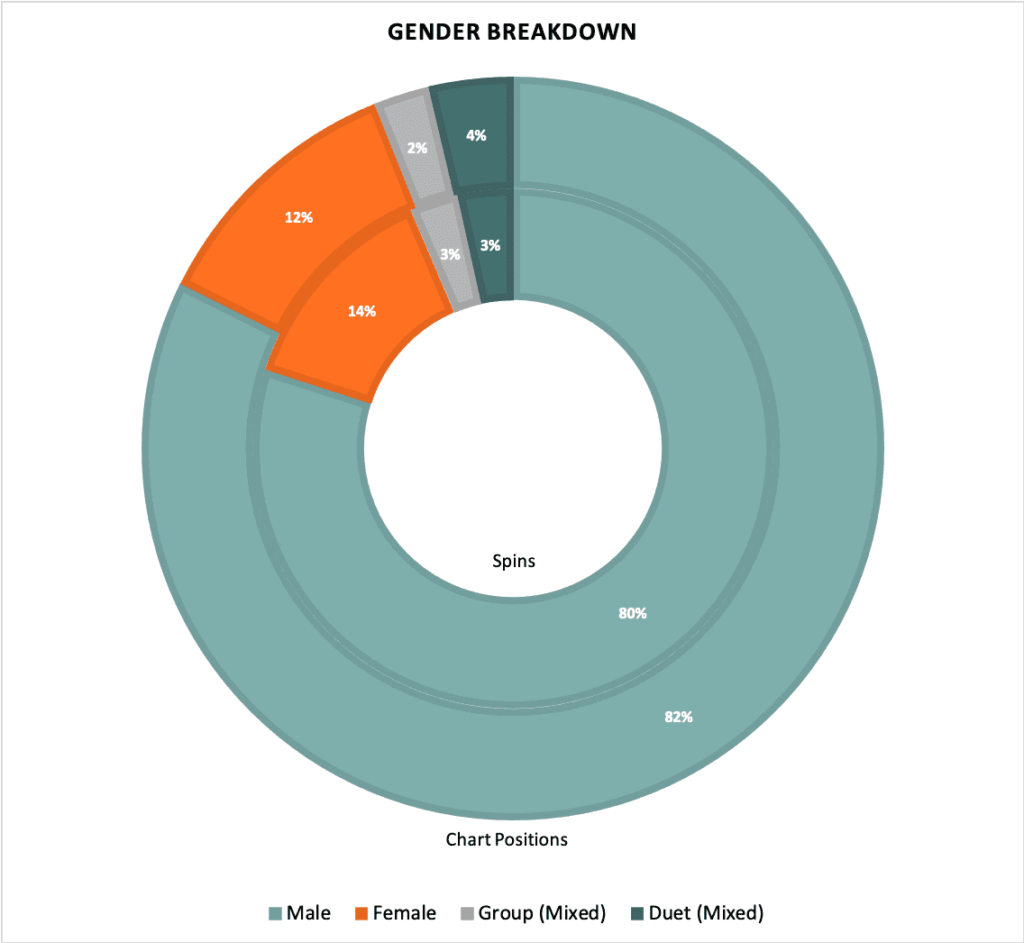
The narrative remains the same: on average eight out of ten songs on the radio are performed by male artists, while only around one out of ten will be by a solo female artist. As bad as these numbers are, the weekly trends on the charts are more telling of the severity of the problem.
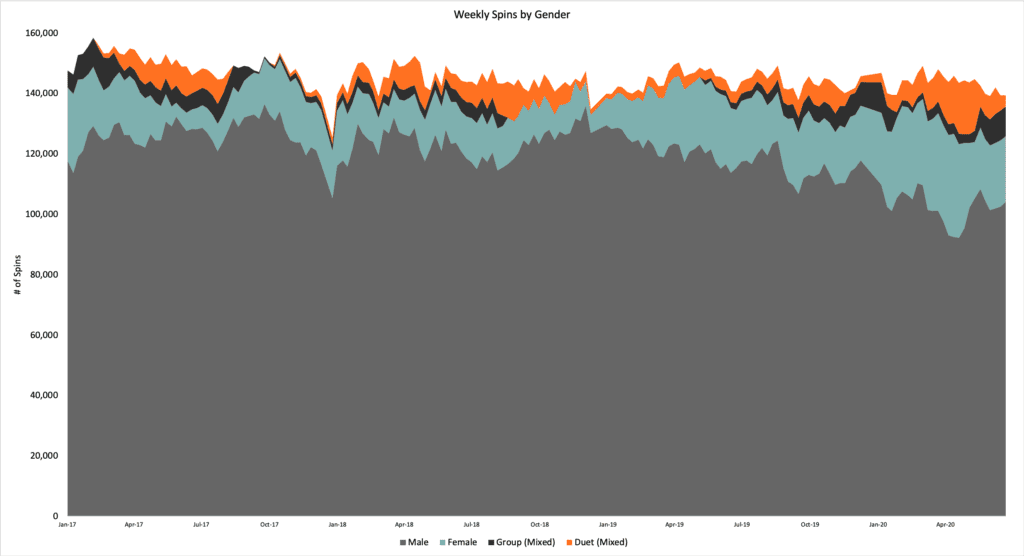
The above figure shows the same breakdown of total spins for the top fifty songs by gender but provides granularity on the change in these metrics from week to week. From this view, it is apparent how the aggregate numbers come out to around 80% of songs being male voices. That is due to the resounding consistency over time, particularly in the size of the light blue layer representing solo female airplay. While there has been a slight improvement at the end of this timeframe, at the very best there were only 11 songs by female artists on the charts (22%). Furthermore, the highest week in terms of female spins was in April 2020 but only featured 23% of spins for solo female artists.
At this point, there is not much else to say about these numbers. Even with the recent slight improvement, the gap in airplay is overwhelming. The most frustrating aspect of this reality is how long this issue has persisted despite the efforts of many to combat it. It is the greatest contributor to the lack of diverse sounds on the radio, even more so than the label consolidation (although there are certainly overlap between the two). This lack of diversity has and continues to drive many away from country radio which is bound to create an impasse in the coming years. Streaming platforms provide consumers the ability to listen to whatever genre, artist or song they want to without commercial interruption – and at increasingly lower costs.
This raises the question of if artists, specifically female artists struggling to establish airplay, should even bother pushing for this agenda. Currently country radio remains the best vehicle to mainstream success, however there is a growing number of artists achieving tremendous results without radio support. A great example of this alternative path to stardom is Kacey Musgraves.
Despite her lack of spins on country radio, Musgraves has won multiple GRAMMYs starting with Best Country Album and Best Country Song in 2014. Then, she won four more in 2019 for Best Country Album, Best Country Song, Best Country Solo Performance and all genre Album of the Year. It was a clean sweep for Musgraves as she won every award she was nominated for, and many were quick to point out this was despite her lack of play on country radio. These accolades have helped her grow her fanbase leading to touring success and making her a marquee artist that will be influential for years to come.
The other great examples of this alternative route are the ever-infamous Appalachian artists Sturgill Simpson and Tyler Childers. Long lauded as independent artists making music more “country” than anything in the mainstream, they developed passionate fan bases through authentic storytelling in their music and dedicated tour schedules. As their careers progressed, they became outspoken about their place in the genre which culminated in two iconic moments.
The first was Sturgill Simpson busking outside the 2017 CMA Awards with his GRAMMY for Best Country Album in his guitar case, as a protest for his exclusion from the event and thoughts on the state of the genre (among other things). Childers’ moment came a few months later at the 2018 Americana Music Awards when he was recognized as the Emerging Artist of the Year. In his acceptance speech, he denounced his identification as an Americana artist, instead insisting he is a country artist and that the existence of Americana is covering up the core issues that plague country music. While some may see these as publicity stunts, these decisions were likely strategic and should actually be studied by other artists for their effectiveness.
While the vast majority of momentum behind these artists are due to their musicality, these events reverberated around the country music landscape and certainly bolstered their reach. They then made another strategic decision in 2019 to tour together with the announcement of the “A Good Look’n Tour” with dates slated for the first half of 2020. Many of these dates have been affected by the pandemic, however the sales leading up to these shows were massive, including multiple sold out shows. Amazingly, these were not small theatre shows that Simpson and Childers used to play. This was scheduled as a full-on arena tour with sold out stops at the US Cellular Center in Asheville, NC (back to back nights), the Masonic Temple Theatre in Detroit, the Anthem in D.C., and the Armory in Minneapolis. At one point, the tour even topped the Bandsintown & Billboard U.S. Top Artists Index, which measures the “hottest” tickets available at the moment.
It is difficult to fathom how impressive these sales were, in venues so large, for artists with such a severe absence on mainstream country radio. Touring is the largest driving force behind revenues in the industry, so Simpson and Childers were on pace to take a giant leap financially in the progression of their careers. Both these artists likely are not in the business for the money, but the demand shown for their entertainment is something that simply cannot be ignored by Nashville any longer. One way or the other, these artists are eroding the power that country radio exerts by garnering market share in the genre without needing to rely on radio.
These are the cases that women in country music should be looking to as a roadmap. Unfortunately, country radio has been continually reluctant to make significant changes in their processes which has ultimately made it very difficult for women to see substantial airtime. While I wholeheartedly wish this were not the case, progress does not seem to be on the horizon. Therefore, country’s women and independent artists should leverage other avenues of career development such as streaming services, social media and relentless touring schedules to bring awareness to their music. Many of today’s biggest artists such as Luke Combs and Kane Brown got their start on social media, which is proving to be an increasingly important method for fan interaction. This is only going to continue with the rise of Tik Tok placing an emphasis on music in viral moments. There have already been multiple examples of songs getting huge bumps in streaming numbers and sales due to the platform, and I predict we will see artists purposely creating songs fit for the environment of Tik Tok in the future (so long as we still have access in the United States).
Ultimately, if artists create music that a large number of fans connect with, they will find their way to the top. Those who care about country music should unquestionably continue to push for women to be given more opportunities on the radio. However, until that day comes when equality is reached, all artists (and women especially) should also look to drive their career growth through alternative mediums.
As powerful as country radio has proven to be, important figures have started chipping away at the aurora of its necessity. I predict radio will continue to lose its influence to streaming platforms and social media, which will present the best opportunity to restore balance to the genre’s gender ratio. Those that adapt to this trend will rise to the top, and those that don’t will fall behind. The world is changing in more ways than one, and I’m hopeful country music changes for the better along with it.





